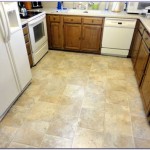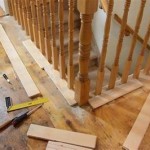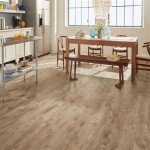Wood Tile Bathroom Flooring Ideas: Achieving Warmth and Durability
Bathroom flooring presents a unique challenge in interior design. The material must withstand constant moisture, temperature fluctuations, and regular cleaning while still contributing to the overall aesthetic appeal of the space. Wood, traditionally considered unsuitable for bathrooms due to its susceptibility to water damage, has found a viable alternative in wood-look tile. This innovative flooring option combines the visual warmth and beauty of wood with the durability and water resistance of ceramic or porcelain tile. Wood tile bathroom flooring offers a versatile solution for achieving a sophisticated and practical bathroom design.
Wood-look tile replicates the appearance of various wood species, grains, and finishes, providing a wide range of design possibilities. From rustic farmhouse styles to sleek modern aesthetics, wood tile flooring can complement diverse bathroom designs. The advancements in tile manufacturing have resulted in highly realistic textures and patterns, making it difficult to distinguish wood tile from genuine hardwood at first glance. Moreover, wood tile is available in various sizes and shapes, including planks, squares, and even patterned formats, further enhancing design flexibility. This article will delve into the various aspects of using wood tile for bathroom flooring, exploring its benefits, styles, installation considerations, and maintenance requirements.
Advantages of Wood Tile in Bathroom Applications
The primary advantage of wood tile flooring in bathrooms is its superior water resistance compared to natural wood. Ceramic and porcelain tiles are inherently waterproof, making them ideal for areas exposed to high humidity and moisture. Unlike wood, tile will not warp, swell, or rot when exposed to water. This characteristic significantly reduces the risk of mold and mildew growth, contributing to a healthier bathroom environment. The low porosity of porcelain tile, in particular, makes it highly resistant to staining and water absorption, further extending its lifespan and reducing the need for frequent repairs or replacements.
Durability is another key benefit of wood tile flooring. Ceramic and porcelain tiles are known for their strength and resistance to scratches, dents, and chipping. This makes them suitable for high-traffic bathroom areas and ensures the flooring will maintain its appearance for many years. The robust nature of tile also makes it resistant to fading from sunlight, preserving the color and finish of the wood-look design over time. This longevity translates into long-term cost savings by minimizing the need for frequent replacements.
Wood tile is also relatively easy to maintain. Its smooth, non-porous surface is simple to clean with regular sweeping and mopping. Unlike natural wood, it does not require special sealants, waxes, or polishes. Most common household cleaners can be used safely on wood tile without causing damage or discoloration. The ease of maintenance contributes to the overall convenience and practicality of wood tile flooring, making it a suitable choice for busy households.
Exploring Different Styles and Designs of Wood Tile
The versatility of wood tile allows for a wide range of design possibilities, catering to diverse aesthetic preferences. Different wood species, colors, and plank sizes can be replicated to create unique and visually appealing bathroom floors. For a rustic or farmhouse-inspired bathroom, wood tile with distressed finishes, knots, and variations in color can be used to mimic the look of reclaimed wood. Wider planks and matte finishes can further enhance the rustic aesthetic. These styles often incorporate textures that simulate the feeling of aged wood, adding to the authenticity of the design.
For a more modern and contemporary bathroom, wood tile with clean lines, uniform colors, and glossy finishes can be selected. Lighter wood tones, such as blonde or gray, are often preferred in modern spaces to create a bright and airy feel. Longer, narrower planks can create a sense of spaciousness and elegance. Minimalist designs with subtle wood grain patterns contribute to a sleek and sophisticated look. The use of larger format tiles can also minimize grout lines, creating a seamless and visually appealing surface.
Beyond replicating traditional wood species, wood tile can also be used to create unique and unexpected patterns. Herringbone, chevron, and geometric patterns can add visual interest and character to a bathroom floor. These patterns can be created using rectangular wood-look tiles laid in specific configurations. Mixing different colors or shades of wood tile can further enhance the complexity and visual appeal of these patterns. A professional tile installer is typically recommended for intricate pattern installations to ensure precise alignment and a flawless finish.
Installation Considerations for Wood Look Tile Bathroom Flooring
Proper installation is crucial for ensuring the longevity and performance of wood tile bathroom flooring. The subfloor must be clean, level, and structurally sound before installing the tile. Any imperfections in the subfloor can cause the tile to crack or become uneven over time. Self-leveling compounds can be used to correct minor imperfections and create a smooth surface for tile installation. The subfloor should also be thoroughly cleaned to remove any dirt, debris, or adhesive residue that could interfere with the adhesion of the tile.
Selecting the appropriate thin-set mortar is essential for a successful installation. The type of mortar should be compatible with both the tile material and the subfloor. Modified thin-set mortars are often recommended for wood tile installations due to their enhanced bonding properties and flexibility. These mortars are designed to accommodate slight movements in the subfloor and prevent cracking. The mortar should be mixed according to the manufacturer's instructions and applied evenly to the subfloor using a notched trowel.
Grouting is another critical step in the installation process. The type of grout used should be resistant to moisture, staining, and mildew growth. Epoxy grout is a popular choice for bathrooms due to its superior water resistance and durability. Cement-based grout can also be used, but it should be sealed properly to prevent water penetration and staining. The grout should be applied evenly to the joints between the tiles and cleaned thoroughly to remove any excess residue. Regular cleaning and sealing of the grout lines are essential for maintaining the appearance and integrity of the flooring.
Consideration should be given to expansion and contraction. Wood tile can expand and contract slightly with temperature changes, so it is essential to leave adequate expansion joints around the perimeter of the room and around any fixed objects, such as pipes or toilets. These joints allow the tile to move freely without putting stress on the surrounding structures. The expansion joints should be filled with a flexible sealant to prevent water penetration and maintain a clean aesthetic.
Underfloor heating systems can be installed beneath wood tile flooring to provide added comfort and warmth. Electric radiant heating systems are typically used for bathrooms, as they are relatively easy to install and control. The heating cables or mats are embedded in the thin-set mortar beneath the tile, providing even heat distribution throughout the floor. Proper insulation should be installed beneath the heating system to maximize its efficiency and minimize heat loss. A programmable thermostat allows for precise temperature control and energy savings.
Finally, it is often beneficial to consult with a professional tile installer for complex installations or if you lack experience with tile work. A professional installer can ensure that the tile is installed correctly, with proper alignment, spacing, and grouting. They can also provide guidance on selecting the appropriate materials and addressing any potential challenges or issues that may arise during the installation process.
Maintaining Wood Look Tile Bathroom Flooring
The maintenance of wood tile bathroom flooring is relatively simple and straightforward. Regular sweeping or vacuuming is recommended to remove dirt, dust, and debris. This prevents the buildup of abrasive particles that can scratch or dull the surface of the tile. Using a soft-bristled broom or a vacuum cleaner with a brush attachment is recommended to avoid damaging the tile.
Mopping with a mild detergent and warm water is typically sufficient for cleaning wood tile flooring. Avoid using harsh chemicals, abrasive cleaners, or scouring pads, as these can damage the finish of the tile. A neutral pH cleaner is ideal for maintaining the appearance and integrity of the flooring. Microfiber mops are particularly effective at removing dirt and grime without leaving streaks or residue. The mop should be wrung out thoroughly to prevent excess water from seeping into the grout lines.
Grout lines can accumulate dirt, stains, and mildew over time. Regular cleaning of the grout lines is essential for maintaining the overall appearance of the flooring. A grout brush and a specialized grout cleaner can be used to scrub the grout lines and remove stubborn stains. Alternatively, a mixture of baking soda and water can be used as a natural grout cleaner. The grout lines should be rinsed thoroughly after cleaning to remove any residue.
Sealing the grout lines can help prevent water penetration and staining. A grout sealant should be applied periodically, following the manufacturer's instructions. The sealant penetrates the grout and creates a protective barrier against moisture and dirt. Regular sealing can significantly extend the lifespan of the grout and make it easier to clean.
Preventative measures can also help maintain the appearance of wood tile bathroom flooring. Using bath mats or rugs in high-traffic areas can help protect the tile from scratches and wear. Promptly cleaning up spills and stains can prevent them from setting into the tile or grout. Avoiding the use of harsh chemicals or abrasive cleaners can prevent damage to the finish of the tile. Regular maintenance and care will ensure that wood tile bathroom flooring remains beautiful and functional for many years to come.

Porcelain Wood Look Tiles For Every Room In Your House

2024 Bathroom Flooring Trends 20 Updated Styles Inc

Bathroom Flooring Ideas The Home Depot

15 Bathrooms That Have Been Transformed With Wood Tile

Elegant Wooden Shower Floor Tiles For A Luxurious Bathroom Remodel

The 60 Coolest Bathroom Tile Ideas To Recreate In Your Home

Rustic Wood Tiles Hardwood Floors For The Bathroom Yes Thankfully There Are That Look Like H Floor Tile Flooring

75 Trendy Wood Look Tile Ideas For Bathrooms Digsdigs
:max_bytes(150000):strip_icc()/terrain-hanging-vase-over-catty-corner-bathtub-5a1f330e9802070036023875.jpg?strip=all)
15 Ideas For Wood Floors In Bathrooms

Revitalize A Bathroom With Faux Wood Porcelain Tiles
Related Posts








